
Original Link: https://www.anandtech.com/show/2138
AMD Socket-F Opteron vs. Intel Woodcrest
by Jason Clark & Ross Whitehead on December 18, 2006 12:05 AM EST- Posted in
- IT Computing
Socket-F vs. Woodcrest
We first started contacting AMD for a Socket-F platform a few weeks before its release date. Typically, when we receive a platform from AMD, it consists of a couple of CPUs, a main board and some memory. This time around AMD decided to send full platforms from a vendor called Colfax (one of AMD's solutions partners). Note that we used the plural of platform: AMD made a fairly bold move and sent a Woodcrest system as well. Both of the systems were configured identically: same case, power supply, hard drives, DVD-ROM and cooling (minus the CPU fans).
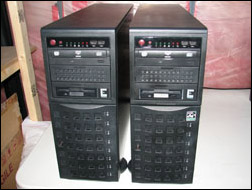 |
| Click to enlarge |
What's new with Socket-F?
Socket-F isn't a huge technological leap for AMD; the most notable change is the move to DDR2 memory. Besides the new memory type however, Socket-F brings hardware virtualization acceleration and better power consumption. All of this is fabricated into a new 1207-pin LGA socket, similar to the LGA design of socket 775 only with more pins in the CPU socket. Here's a quick overview of the currently shipping 2-way Socket-F Opterons.
| AMD Socket F Overview | ||
| Model | Clock | Power Consumption |
| 2210 | 1.8GHz | 95W |
| 2212 | 2.0GHz | 95W |
| 2212 HE | 2.0GHz | 68W |
| 2214 | 2.2GHz | 95W |
| 2214 HE | 2.2GHz | 68W |
| 2216 | 2.4GHz | 95W |
| 2216 HE | 2.4GHz | 68W |
| 2218 | 2.6GHz | 95W |
| 2220 SE | 2.8GHz | 119.2W |
Socket-F System
The Socket-F system has two 2.6GHz (2218) processors mounted on a Tyan S3992 main board, with 8x1GB of DDR2-667 OEM memory. Internal cooling consists of five 3.5" fans and two CPU fans. Internal storage is provided by two WD1600YD hard drives configured in RAID 0, which is where the OS is installed.
Opteron 285 System
The Opteron 285 system consisted of a Tyan S2891 motherboard and 8 x 1GB of PC3200 DDR memory. We powered the 285 out of the Socket-F case, to keep the power measurements accurate. Internal cooling was identical to the Socket-F system, as the motherboard was placed inside the Socket-F system. The internal drives from the Socket-F were also used, to keep the measurements identical.
Woodcrest System
The Woodcrest system is configured with two 3.0GHz Xeon 5160 processors, seated in a SuperMicro X7DBE+. We also swapped out the processors and tested with two Xeon 5150 (2.66GHz) CPUs to provide a second reference point. The Woodcrest system is outfitted with 8x1GB 667 MHz OEM FB-DIMMS. Internal cooling consists of five 3.5" fans, with plastic ducting directing airflow across the CPUs and FB-DIMMs (shown below). Internal storage once again comes from two WD1600YD hard drives configured in RAID 0 with the OS installed.
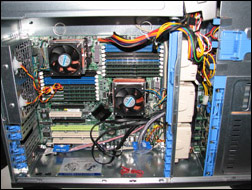 Socket-F Server |
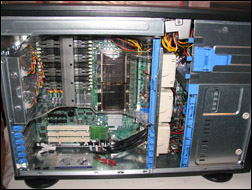 Woodcrest Server |
| Click to enlarge | |
RAID Storage
LSI Logic 8480E MegaRaid Controller
Promise VTRAK J300s SAS Chassis
12 x 146GB Fujitsu 15,000 RPM SAS Drives configured in RAID 0
Operating System/Software
Windows 2003 Enterprise SP1 x64
SQL 2005 Enterprise x64
Test Client
Dual Opteron 285 with 8GB of memory.
Benchmark Methodology
For AnandTech Database Benchmarks, we have always focused on "real world" Benchmarks. To achieve this, we have used real applications with loads such that CPU utilization was 80-90%. Recently we discussed how most Enterprise Database Servers do not average 80-90% CPU utilization, but rather something closer to the 30-60% range. We thought it would make more sense to show performance where it is most likely going to be used, as well as the saturation numbers for the situations where the CPU is maxed.
We feel this is consistent with how GPUs are reviewed, and how you might test drive a car. With GPUs, the cards are tested with varying resolutions, and anti-aliasing levels. With a car, you don't just hit the highway and see what the top end is.
We settled on six load points 20%, 40%, 60%, 80%, 100%, and 120+% for testing the varying ranges of load. These load points are consistent across all platforms and are throttled from the client, independent of the platform being measured. We chose these load points as they split the load range into 6, roughly, equal parts and allow us to extrapolate data between the points. The 120+% load point was included to verify that our 100% load point really was 100%.
The 100% load point was determined by starting an execution of the client and adding threads until the CPU utilization was between 95% and 100%. The other load points were determined by altering the number of threads from the client, thus adjusting the rate of client request per second, until the appropriate ratio of Orders/Minute for Dell and Transactions/Minute for Forums was obtained relative to the 100% load point. These thread counts were recorded and maintained consistent across all platforms.
For any given load point, there is a defined number of threads. Each test is 20 minutes in duration, which includes an 8 minute warm up period followed by a 12 minute measured period. For a given load point, the client submits requests to the DB server as fast as the DB server will respond. The rate which the client is able to submit requests is measured during the final 12 minutes of the test and averaged to determine the Orders/Minute for Dell, and Transactions/Minute for Forums.
After much blood, sweat, and almost tears we were able to produce repeatable loads with an average deviation of 1.6%.
For each platform we ran the test 5 times for each load point and than averaged the 5 results, this was repeated for all loads, all tests, on all platforms... that is 300 test executions!.
Dell & Forum SQL Trace Analysis
The Dell and Forum benchmarks are quite different workloads, which you will see in the benchmark results. Dell executes approximately 10 times more queries during the test, and the durations are approximately 4 times less than that of the Forum benchmark durations. To summarize, Dell is a workload with a high transaction volume, and each query executes in a very short amount of time. The Forum workload has a medium transaction volume, and the queries execute in a reasonable amount of time but are much more read intensive (larger datasets are returned).
Dell DVD Store Information
Dell DVD Store (Orders per minute)
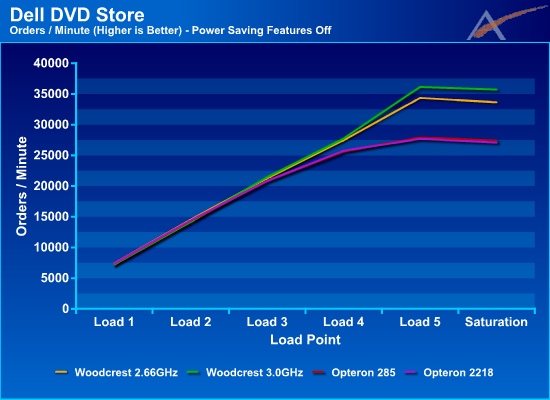
Without any power saving features turned on, all four systems perform about the same for the first three Load Points. After the third Load Point the Woodcrest systems start to pull ahead and finish with a 23% lead at the fifth Load Point. It is interesting to note that the performance of the Opteron systems is almost identical. So what did Socket-F bring then, power saving? Also note, the performance of the Woodcrest systems is also very similar until after the fourth Load Point.
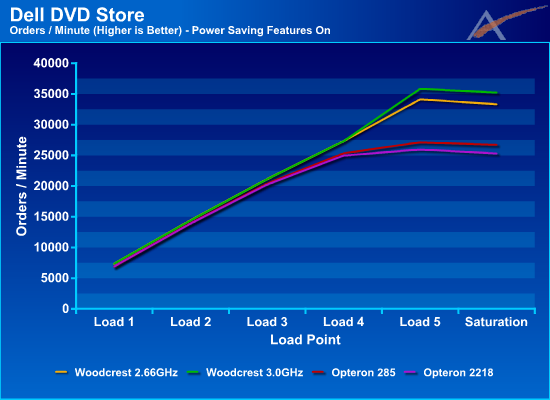
With all power saving features turned on, the performance is not all that different... which is a good thing! One small difference is that the 285 is now slightly faster than the 2218 beyond the fifth Load Point. The question is, is the 285 using more power to obtain slight faster performance?
Dell DVD Store (CPU Utilization)
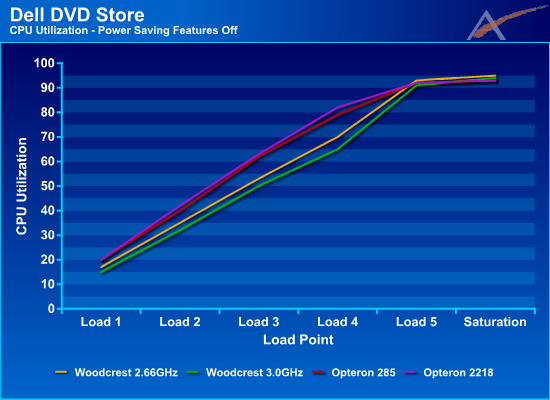
These CPU utilization graphs show that the Opteron based systems tend to require more CPU to keep up with the Woodcrest systems. It is interesting to note that in the performance graph the Opteron has faded a little after the third Load Point but the CPU utilization is only about 80%. This could mean that more than just clock speed is holding the Opteron back at higher Load Points.
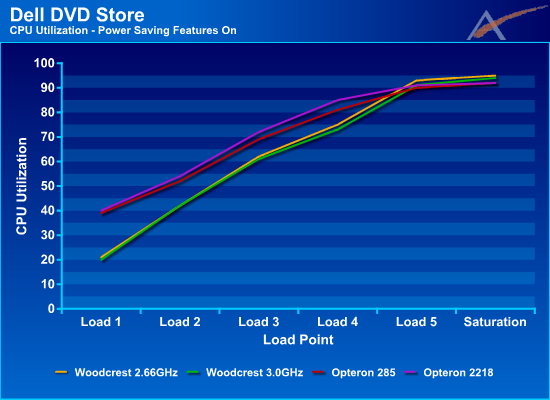
With power saving feature turned on things look a little different this time around. Both platforms require more average CPU to generate the same data rate as with power saving features off. The difference between the Opteron and Woodcrest is about the same except for the lowest Load Point, where the Opteron logged approximately double the amount of CPU use as it did when power saving features were turned off.
Dell DVD Store (Power Consumption)
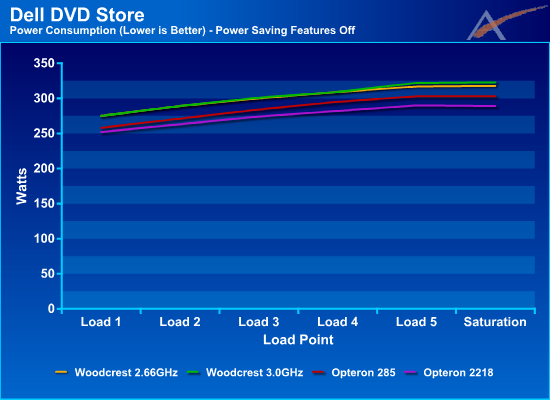
Looking at raw power requirements, Opteron 2218/Socket-F does use slightly less power - about 4% - than the 285 and Socket-F uses approx. 9% less power than the Woodcrest systems. The two Woodcrest configurations are almost identical despite their 12% difference in clock speed.
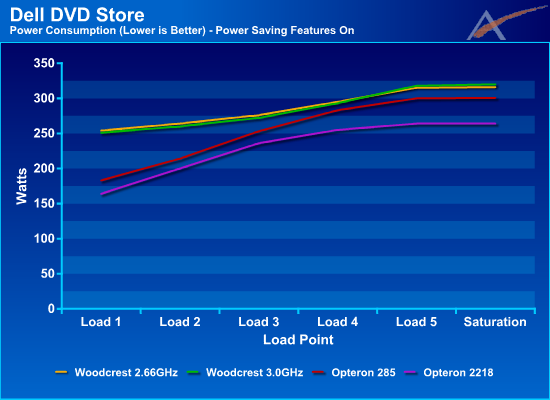
With all power saving features turned on all systems consume a little less power, but it is most apparent with the Opteron. Again Socket-F is able to outperform all other platforms and beats the 285 by as much as 12% and the Woodcrest systems by as much as 35%. Will this be enough to offset its slightly lower performance and allow it to take the lead in Performance/Watt? Let's find out....
Dell DVD Store (Performance/Watt)
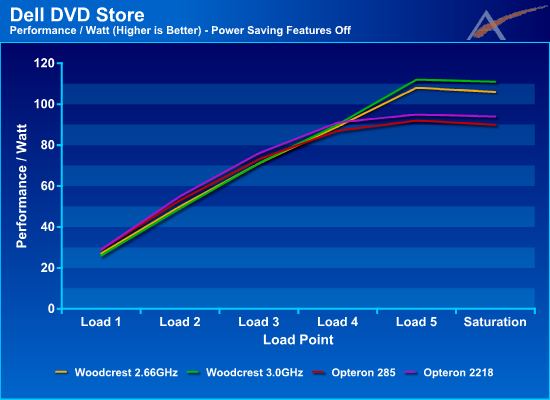
It is a tight race again until after the third Load Point. From the first to the third Load Points, Socket-F is able to outperform the other systems be as much as 12%. After the third Load Point the Opteron seems to lose its wind and is almost tied with Woodcrest, while at the fifth Load Point Woodcrest is 15% better.
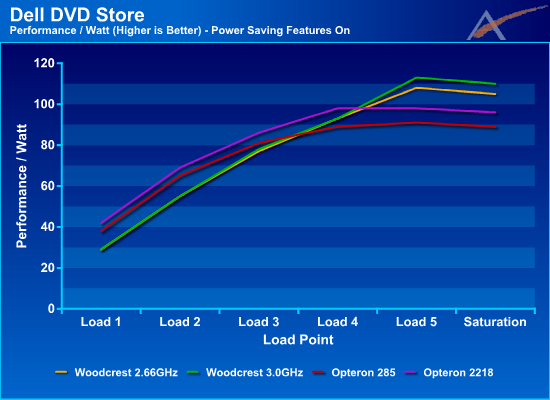
As we expect, when we turn on all power saving features all platforms are able to do a little better. The Opteron is the platform which shows the most improvement. In this case Socket-F is the clear winner until after the fourth Load Point and is able to lead by as much as 35%. At the fifth Load Point Woodcrest is once again ahead by 17%.
Forum Benchmark Results (Transactions/minute)
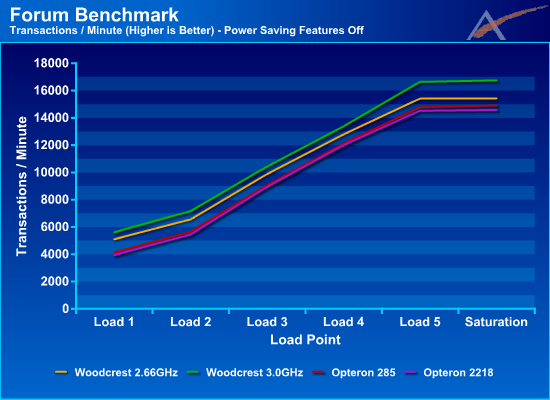
The Forums results are interesting compared to the Dell results. The Forums results show a significant difference between the clocks of Woodcrest, and also between Woodcrest and Socket-F at all Load Points. In the Dell test the Opterons were able to hold on for the first three Load Points but that is not the case here. Woodcrest 3.0 leads all the way by as much as 30%. Also, the Opterons do not seem to lose their wind at Load Point four; they seem to scale much more linearly here.
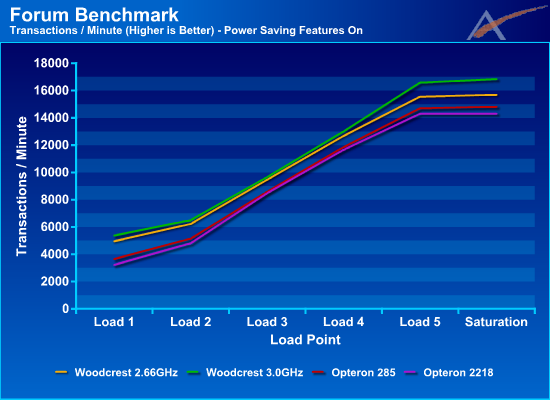
Turn on all power saving features, and the picture is similar, again a good thing
Forum Benchmark (CPU Utilization)
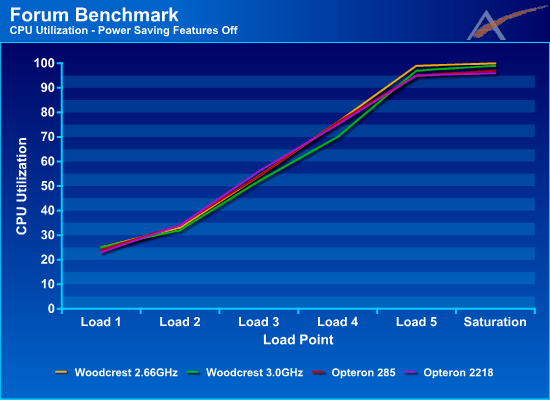
Again, the Opteron results are much more linear and all platforms are more similar than in the Dell test.
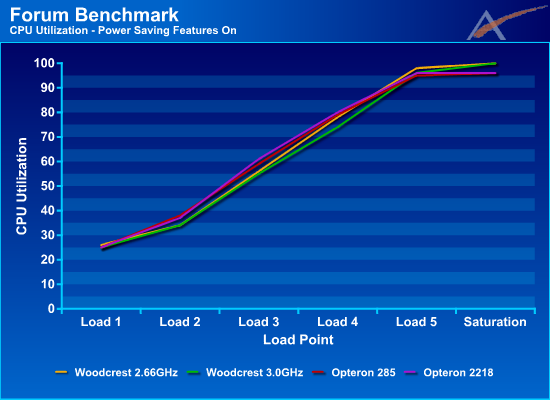
With all power saving features turned on... you might think we forgot to turn them on from a CPU utilization perspective. This is a very different scenario than we saw with the Dell Test where every platform recorded more CPU usage, especially the Opteron systems at the lower Load Points.
Forum Benchmark (Power Consumption)
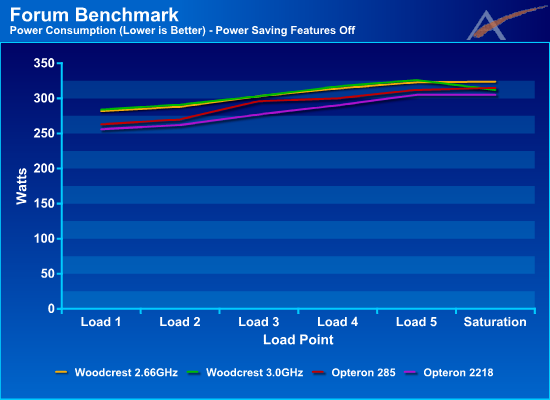
In this test, the results are very similar to the Dell test results with Socket-F using the least power and able to lead by as much as 10%.
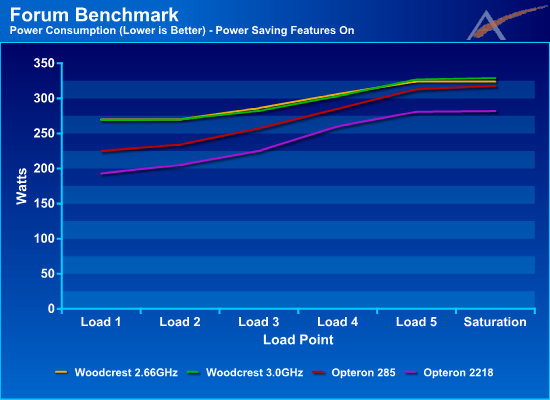
With power saving enabled, things are still not all that different from the Dell results. Socket-F is the clear leader and leads by as much as 29%. Both Opteron servers yield the most savings in power use, likely due to the fact that the FB-DIMMs on the Xeon platform account for a significant portion of the total power draw.
Forum Benchmark (Performance/Watt)
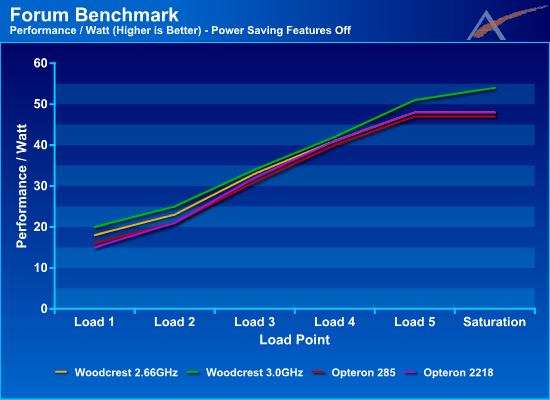
We see that the Opteron results are linear with this Forums test. Woodcrest 3.0 is the clear leader. Woodcrest is able to lead the Opterons by as much as 22%, but that lead is as small as 2% at the fourth Load Point.
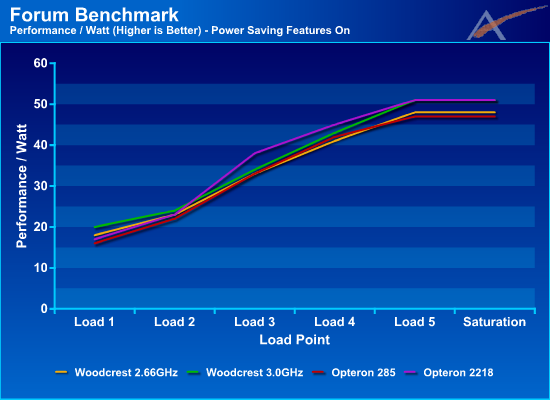
With all power saving features turned on, the tables turn and Socket-F is able to close the gap and take the lead for the third and fourth Load Points. It also manages to tie Woodcrest 3.0 at the fifth Load Point (as well as at the Saturation Point).
Conclusion
Seeing as we believe that most servers do not operate at CPU utilizations levels which approach saturation, Socket-F has done very well. It is able to keep up to Woodcrest for the first 3/5 of the Load Points and with less power. Many companies will add more servers/CPUs/etc. once they are running at over 60% CPU utilization, so we do feel that the first three Load Points are the most meaningful. Yes, Woodcrest is faster, but the FB-DIMMs do serve to hinder performance and performance/Watt in our testing.
It would appear the major difference between the Opteron 285 and 2218 is power consumption. 2218 is comparable on performance but uses significantly less power at the same time. Is this any indication about what we can expect from K8L? If K8L keeps the low power requirements but improves performance over AMD's current offerings, they should be in good shape later this year.
Some might wonder if a different - read Intel - motherboard for the Woodcrest system could have significantly altered the outcome of these tests. We do not think so. Although the Intel motherboards do tend to show slightly lower power consumption, it is not a significant difference. All things considered, the Opterons are holding their own and doing very well for an architecture which is 3.5 years old. Only companies that are routinely running their servers near capacity are likely to truly benefit from an upgrade at this point in time.







